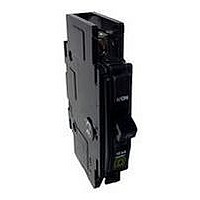QOU115 SQUARE D, QOU115 Datasheet - Page 4

QOU115
Manufacturer Part Number
QOU115
Description
CIRCUIT BREAKER, THERMAL MAG, 1P, 15A
Manufacturer
SQUARE D
Series
QOUr
Type
Thermal/Magneticr
Datasheet
1.QOU1100.pdf
(32 pages)
Specifications of QOU115
Actuator Style
Toggle
No. Of Poles
1
Current Rating
15A
Voltage Rating Vac
240V
Mounting Type
DIN Rail
Voltage Rating Vdc
48V
Actuator Type
Handle
Brand/series
QOU Miniture — Low Ampere
Number Of Poles
1
Special Features
Visi-Trip® Trip Indicator
Voltage Rating
120 V
Leaded Process Compatible
No
Rohs Compliant
No
Lead Free Status / RoHS Status
Contains lead / RoHS non-compliant
QOU Miniature Circuit Breakers and Switches
Application Information
4
© 2005 Schneider Electric All Rights Reserved
Thermal Trip
The thermal trip element of a circuit breaker is a root-mean-squared (rms) current sensing device. The
thermal element, or bimetal, is constructed from metals with dissimilar rates of expansion bonded
together. The thermal element responds to overloads by reacting to the heat generated both by the
current flowing through the circuit breaker and by the heat contribution from ambient conditions. The
bending force of the bimetal causes the circuit breaker to trip (see Figure 1). The deflection of the
bimetal is predictable as a function of current and time. This is the inverse time tripping characteristic of
the thermal element, i.e., the tripping time decreases as the magnitude of the current increases.
Square D calibrates the thermal elements and they are not field-adjustable. The thermal trip elements
are calibrated for 40° C (104° F) ambient temperature, per UL Standard 489 and CSA Standard C22.2
No. 5-02.
Figure 1:
Magnetic Trip
The magnetic (instantaneous) trip element uses an electromagnetic assembly to trip the circuit breaker
instantaneously (with no intentional delay) at or above a predetermined current value. During a short
circuit of sufficient magnitude, the high-level current passing through the conductor rapidly increases
the magnetic field of the electromagnet that attracts the armature. As the armature is drawn toward the
electromagnet, it initiates an unlatching action and opens the circuit breaker contact (see Figure 2).
Figure 2:
Trip Indicator
When the QOU miniature circuit breaker is tripped, the handle assumes a position between ON (I) and
OFF (O) and the red Visi-Trip
circuit breaker and Visi-Trip indicator by pushing the handle to OFF and then to ON.
Armature
Current In
Current In
Bimetal
Normal Conditions
Normal Conditions
Thermal Tripping
Magnetic Tripping
Latch
Latch
Conductor
Electromagnet
Spring
®
Current Out
Spring
indicator (A) appears in a window in the circuit breaker case. Reset the
Circuit Breaker
Contacts
Current Out
Circuit Breaker
Contacts
Normal Conditions
Thermal Trip
09/2005














